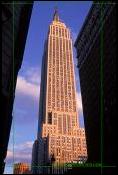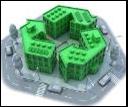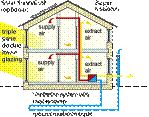

|
DEVENS ECO-EFFICIENCY CENTER Helping area businesses and organizations reduce their environmental impacts and operating costs through education, collaboration and technical assistance. |
|
Green Building Roundtable Resource Library The following is a summary of past Green Building Roundtable topics, along with links to some of the resources that were provided: |
|
Green Building and the Bottom Line: the business case for sustainable building design — June 2008 The June Roundtable was held at Fidelity Bank’s new headquarters which was designed and constructed using the New Buildings Institute’s “Advanced Buildings Benchmark” rating system. Participants discussed the benefits of sustainable building design and how it affects the triple-bottom line (economy, environment, social) and learned about Fidelity’s decision to “go green” and the results to-date. View Select slides from the Green Building Presentation here and to view select slides from the presentation on the Advanced Buildings Benchamark and Fidelity, click here. The workshop closed with an interactive tour of the building. and check out the local news coverage of the event. |

|
Low-Impact Development Techniques - Oct. 2008 This session discussed the pros and cons of various LID techniques and how these methods can save money and promote better storm water management on-site. After discussing LID and the MA DEP’s new State Stormwater management Standards participants spoke with the design engineer and owner and operator of One Jackson Place who recently installed biofiltration landscape islands at their facility in Devens. Participants were able to view the functioning LID techniques first-hand and discuss design, construction, operation and maintenance issues and the pros and cons of LID. Participants left with a better understanding of where LID approaches can be implemented and how they can save on upfront materials costs as well as long term-maintenance. The following are links to some of the resources that were made available to attendees:
|


|
Green Buildings Roundtable -- March 2008 The first Green Building Roundtable brought together a wide range of professionals to share information on experiences with sustainable development practices and green materials and highlight current projects and areas of interest. A number of green building resources and rating systems were discussed in detail. Check out the following links for more information. |



|
Existing Buildings: Greenest of Green Buildings — Jan. 2009 Existing buildings contain a tremendous amount of embodied energy. Adaptive reuse/renovation can be a more cost-effective, efficient and sustainable method of construction versus building new. Devens has numerous examples of adaptive reuse of existing buildings and numerous opportunities to "green" existing buildings. In this Roundtable we heard from a number of architects, engineers and building owners and operators about some of the pro's and con's regarding existing buildings. A number of great resources were discussed:
Historic Preservation and Green Building Thanks to EcoStar Member Al Collins of Habitat Advisory Group for the Article on Historic Building Preservation—an insightful read! USGBC LEED for Existing Buildings Operations and Maintenance Rating System |

|
Getting to Zero Energy Building -- April 2009 In this session we discussed some of the latest advancements in energy efficient building design. Participants shared their experiences with implementing cost-effective solutions to constructing and renovating buildings to maximize energy efficiency. Carter Scott from Transformations, Inc. gave a great overview of how he is building Zero-net energy homes today. We went over proposed changes to the MA building code, as well as a look at the final report from the Governor's Zero-Net Energy Building Task Force—two steps Massachusetts is taking to help lead the path towards zero-energy building and the goal of meeting our carbon reduction targets by 2030. We also touched on passive survivability and plus-energy buildings that are essentially becoming decentralized power suppliers. The following are links to the presentations and some of the resources that were made available to attendees:
|

|
Passive Energy Building Design and Construction—Sept. 2009 As a spin off from our April Green Building Roundtable on Getting to Zero Energy Building, this Roundtable focused on Passive Energy Design which is quickly growing in popularity again as energy costs remain unstable and nations, cities, towns and individuals strive to reduce their carbon footprint to combat global climate change. Participants from both the residential and commercial/industrial sector discussed the latest in energy efficient building techniques and Passive House Design standards. We also viewed a short film on a Passive and Active solar mixed use development in Germany which utilizes a number of Passive House standards. Many resources and funding programs were shared and discussed at this session. Below are links to those resources:
Presentation Slides and Passive Energy Resources Design of Passive Solar Heated Buildings |

|
Construction and Deep Energy Retrofits -- January 2010 As interest in energy efficient design and construction remained a key topic for this roundtable group, this quarter’s roundtable focused on foundation construction methods to control moisture. In the second half of the session, we discussed super-insulation and other deep-energy retro-fits and some of the opportunities and challenges in implementing these methods into new construction and existing buildings. We finished off with a quick look at the deep energy retrofits of the Empire State Building and provided some valuable resources for attendees.
Construction and Deep Energy Retrofit Presentations (this is a large file and may take a minute to download!) |

|
Adaptive Reuse: Grady Research Building Tour — April 2010 Members heard from John Grady about his restoration efforts and challenges in redeveloping this former trolley company building that was converted into an icehouse and now houses Mr. Grady’s research facility and hydro-power facility that can generate enough energy to power up to 300 homes. |
|
IGCC & ASHRAE Standard 189.1-- July 2010 The International Code Council's recent release of the International Green Construction Code includes ASHRAE Standard 189.1 (modeled on the USGBC's LEED Green Building Program) as a “total building sustainability package”. Standard 189.1 serves as a jurisdictional compliance option to the Public Version 1.0 of the International Green Construction Code (IgCC). Chris Schaffner, P.E., LEED AP, a nationally recognized expert in cost effective, high-performance design, provided a great overview of Standard 189.1 and got an insightful discussion rolling.
|


|
Reducing Toxicity in Buildings/Building Materials— Oct. 2010 Toxicity in building materials can lead to serious indoor air quality problems and jeopardize the health of your employees. Participants discussed information and resources available to help make smarter choices in building materials, paints, coatings, adhesives as well as cleaning and maintenance practices. For additional information and valuable resources, download the presentation here:
|

|
Design For Reuse: Sustainable Design/Deconstruction-- Jan. 2011 This roundtable focused on the emerging trend of designing buildings to be deconstructed or reused. Past roundtables have focused on building longer-lasting buildings and moving away from our current disposable design and build practices. We went a step further and looked at ways people are deconstructing buildings and reusing the materials to construct new buildings (really extending the life-cycle of building materials!). We discussed how to incorporate reuse strategies into new building designs and looked at some sample reclaimed materials and local resources for reuse.
|

|
PEAK WATER: Building for Water & Energy Efficiency—April 2011 This Roundtable discussed "peak oil" - the term used to characterize the point of maximum production capacity of oil as a finite resource. As oil supplies diminish and demand grows, it becomes a supply-demand struggle with serious triple-bottom line impacts (economy, environmental and social). We discussed who people are already planning, designing and constructing buildings, neighborhoods and cities with water efficiency in mind - doing much more with less. We also discussed the latest trends in water efficient building design and construction. |

|
Tour of Sustainable Housing at Devens—July 2011 In conjunction with the US Green Building Council MA Chapter, this quarter’s roundtable took participants on an interactive tour of two new sustainable housing projects in Devens. Click here for details or see below for more specific information from the tour.
Transitions at Devens - a 13-unit multi-family residential transitional shelter for homeless, single women with children. This project integrated sustainable building and low-impact site design features to achieve LEED for Homes Gold certification from the US Green Building Council. Architects Overview (large file—may take a minute to download)
For more information on the design of this building, contact Janet Buck of Buck, Smith, McAvoy Architects, Inc.
Devens Green – Right across the street from Transitions is the first of eight single-family homes that is currently under construction in what will soon be a neighborhood of net-zero energy and positive energy homes.
Transformation’s Green Features
For more information on the design of this building, contact Carter Scott of Transformations, Inc.
Both of these projects are excellent examples of how the development at Devens is meeting the sustainable redevelopment goals and advancing the triple bottom-line benefits (social, environmental and economic).
|



|
Building Energy Performance: Top 10 Energy Efficiency Measures for Demand Reduction—January 2012 In partnership with the USGBC Massachusetts Chapter, this roundtable was a USGBC webinar that focused on reducing energy demand on building systems. Participants learned about innovative systems designs that can reduce energy usage in buildings. Presenters explored energy modeling as a design tool and keys to successful implementation beyond baseline energy performance.
After the webinar, participants engaged in an informative discussion about some of the opportunities and challenges that builders and designers face when trying to implement such energy performance measures in the real world. Thanks to all who participated! Download select slides from the presentation here. |
|
Mastering Healthy Building Materials—July 2012 We again partnered with the MA Chapter of the US Green Building Council for this roundtable that involved an overview of sustainable building designs elements that focus on not only energy and water efficiency but also reduction of toxic materials. The webinar portion of this roundtable included a panel discussion on how specific businesses and organizations such as USGBC, Google, Gensler and the International Living Building Institute are approaching this challenge. Download select slides from the presentation here. |



|
Residential & Commercial Applications for Passive House January 2013 We reviewed some of the latest Passivhaus Energy Design concepts and looked at some successful examples of how builders are integrating these into residential as well as commercial projects across the country and here in New England. We ended the session with a comparison of Passive house vs. LEED and reviewed some great resources and funding opportunities. Download select slides from the presentation. Check out the recent on-line blog posting on this roundtable from one of our attendees. |

|
Breathing Life into New and Old Buildings: Designing for Indoor Air Quality—April 2013 Special guest speaker David Bearg, with Life Energy Associates, presented on the triple bottom-line benefits of good indoor air quality and balancing natural vs. mechanical methods to control moisture and ventilation. For every dollar we spend on improving ventilation, companies can get up to $6 back in employee productivity in reduced sick days and increased occupant comfort and well-being. Check out this and many other great facts here in select slides from the presentation. |
